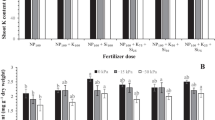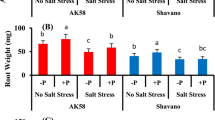Summary
Rice plants (Oryza sativa L.) were grown for 125 days in nutrient solutions maintained at constant potassium concentrations over the rate 51 to 1534 μM. Data are recorded at different growth stages for relative growth rate, potassium content, absorption rate of this element per gram dry weight of roots per day and its utilization in dry-matter production. Optimum concentration for maximum growth was found to be about 256 μM or 10 ppm potassium. Growth was more or less constant beyond this concentration. The maximum growth was characterized by a certain relative absorption rate (IM) for maximum growth ranging from 106 to 757 μg-atom of potassium per g dry weight of roots per day, during the period of cultivation. In general the content of this element in tops as a percentage of the total content does not change appreciably either under different concentrations or at different ages. When the concentration of the solution increased, the utilization of potassium (dry-matter production per unit element content) decreased. The ratio between the relative growth rate (RGR) and relative absorption rate (IM) for maximum growth of rice ranged 1.4 during the first phase of growth to 1.3 at maturity of the crop. Higher ratios indicate an insufficient nutrient supply, lower ratios, however, either an abundant supply or a depressing effect of the solution on growth.
Similar content being viewed by others
References
Ahlgren G. H., Some effects of volume rate of solution supply and of potassium concentrations of the growth of white clover. Soil Sci. 52, 229–235 (1941).
Asher C. J. and LoneraganJ. F., Response of plants to phosphate concentration in solution culture: I. Growth and phosphate content. Soil Sci. 103, 225–233 (1967).
Asher C. J. and OzanneP. G., Growth and potassium content of plants in solution cultures maintained at constant potassium concentrations. Soil Sci. 103, 155–161 (1967).
Barber, S. A. and Humbert, R. P., Advances in knowledge of potassium relationships in the soil and plant in fertilizer technology and usage. Symposium Publ. by Soil Sci. Soc. Amer., Madison Wis. (1963).
Epstein E., RainsD. W. and ElzamO. E., Resolution of dual mechanisms of potassium absorption by barley roots. Proc. Nat. Acad. Sci. 49, 684–692 (1963).
Fageria, N. K., Uptake of nutrients by the rice plants from dilute solutions. Doctoral thesis, Catholic University of Louvain, Belgium.
Freeman G. G., Studies on potassium nutrition of plants. I. Effect of potassium concentration on growth and mineral composition of vegetable seedlings in sand culture. J. Sci. Food. Agr. 18, 171–176 (1967).
Harper J. E., Seasonal nutrient uptake and accumulation patterns in soyabeans. Crop. Sci. 11, 347–350 (1971).
Jackson M. L., Soil chemical analysis. Englewood Cliffs. Prentice Hall Inc., New Jersey. (1958).
Jacobson L., OverstreetR., KingH. M. and HandleyR., A study of potassium absorption by barley roots. Plant Physiol. 25, 639–647 (1950).
Lastuvka Z. and MinarJ., The relation between nutrient solution concentration and growth and ion absorption of peas (Pisum sativum L). I Growth of peas. Plant and Soil 32, 189–197 (1970).
Lastuvka Z. and MinarJ., The relation between nutrient solution concentration and ion absorption of peas (Pisum sativum L). II. Accumulation, distribution and utilization of nitrogen, phosphorus and potassium. Plant and Soil 32, 412–423 (1970).
Loneragan J. F. and AsherJ., Response of plant to phosphate concentration in solution culture. II. Rate of phosphate absorption and its relation to growth. Soil Sci. 103, 311–318 (1967).
Marches A. G., MottG. U. and BulaR. J., Vegetative development of alfalfa seedlings and potassium fertilization. Agron. J. 54, 541–543 (1962).
Mullison W. R. and MullisonE., Growth responses of barley seedlings in relation to potassium and sodium nutrition. Plant Physiol. 17, 623–644 (1942).
Singh D. P. and SinghJ. N., Uptake and accumulation of phosphorus by Japanese mint (Metha arversis L.) as affected by phosphorus deficiency. Indian J. Agr. Sci. 41, 265–270 (1971).
Wall M. E., The role of potassium in plants III. Soil Sci 49, 393–408 (1940).
Welch R. M. and EpsteinE., The dual mechanism of alkali cation absorption across the plasmalemma. Proc. Nat. Acad. Sci. U.S.A. 61, 447–453 (1968).
Williams D. E., The absorption of potassium as influenced by its concentration in the nutrient medium. Plant and Soil 15, 387–399 (1961).
Williams R. F., The effects of phosphorus supply on the rates of intake of phosphorus and nitrogen and upon certain aspects of phosphorus metabolism in gramineous plants. Australian J. Sci. Research 1, 333–361 (1948).
Author information
Authors and Affiliations
Rights and permissions
About this article
Cite this article
Fageria, N.K. Influence of potassium concentration on growth and potassium uptake by rice plants. Plant Soil 44, 567–573 (1976). https://doi.org/10.1007/BF00011376
Received:
Issue Date:
DOI: https://doi.org/10.1007/BF00011376




